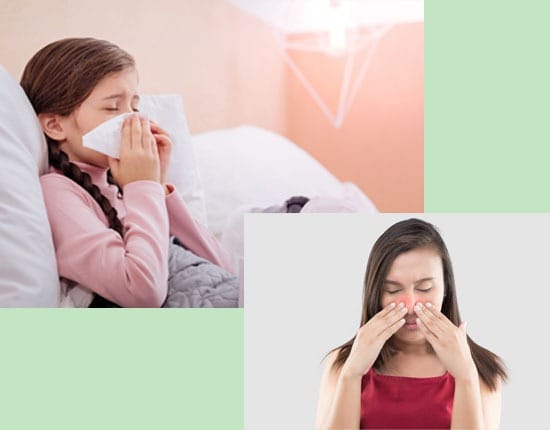- +91 9874182825
- info@allergyandasthmacentre.com
- Clinic : 10:00AM To 06:00 PM
How To Get Rid Of Dust Allergy?
Did you know that over 20 million adults in the U.S. suffer from dust allergies? Constantly sneezing is an active symptom of dust allergy. In this guide, we will discuss some simple and effective ways of reducing dust in your environment, to help you breathe easier and more. Let’s get into it!
Understanding Dust Allergies
Dust Allergies happen when the immune system reacts to allergens that are found in dust. Some of the common sources of dust allergens are:
Pet Dander
Skin flakes from pets like dogs and cats.
Dust Mites
Tiny creatures that thrive in upholstery, bedding and carpets.
Cockroach Droppings
Waste products from cockroaches are also known to trigger dust allergies.
Pollen
Tiny grains from plants that can mix with dust also trigger dust allergies.
Mold Spores
Fungi grow in damp areas, which triggers dust allergies. When the body comes into contact with these allergens, it overreacts and causes allergy symptoms.
What Are Some Common Symptoms Of Dust Allergies?

It becomes essential to recognize the symptoms of dust allergy. This is because it is the first step to managing it. A few common symptoms include:
- stuffy and runny nose
- sneezing
- skin rashes
- coughing
- postnasal drip
- red, itchy and watery eyes
- wheezing or difficulty breathing
If you regularly experience these symptoms, especially when you are in dusty/home environments then that indicates you have a dust allergy.
Ways To Reduce Dust Allergy
Now finally answering your question on how to get rid of Dust Allergy! Here is a list of ways through which you can reduce Dust Allergies:
Maintain Cleanliness In the Home
The first step to the cleanliness of the home is a regular dusting of surfaces. This helps in trapping dust instead of spreading it around. Do not forget to clean the areas of shelves, baseboards and other such areas where dust accumulates.
You also need to vacuum your floors at least once a week. Consider vacuuming the place with a HEPA filter. This will trap any tiny particles. If it is possible, you should also vacuum curtains and upholstered furniture as well.
Control Humidity
- Dust mites tend to thrive in humid environments. By keeping humidity levels below 50%, you can reduce their numbers. You can consider making use of dehumidifiers, especially in damp areas like basements.
- Or you could open windows and use exhaust fans to allow moisture to escape when showering or cooking.
Wash Bedding Regularly
- Bedding is another major area where dust mites tend to thrive. You need to wash pillowcases, sheets and blankets in hot water at least once a week.
- Consider using allergen-proof covers on mattresses and pillows to reduce exposure.
Opt For Hard Flooring
Carpets trap both dust and allergens. If possible, you can consider replacing carpets with hard flooring like laminate, tile, or wood whichever is easier for you to clean.
If you have carpets then make sure to clean them regularly.
Prevent Clutter
Having clutter means it will collect dust and will serve as a hiding spot for allergens. You need to keep surfaces tidy and minimize keeping decorative items that collect dust.
Make sure to regularly clean items like knickknacks and books.
Limit Indoor Plants
While having indoor plants does improve air quality, they also attract mould. If you have houseplants, then make sure to keep the soil dry and avoid overwatering. This is because it can lead to mould growth.
Get Air Purifiers
Using air purifiers that have HEPA filters can aid in reducing dust particles present in the air. They can be placed in common areas like bedrooms and living rooms to improve the quality of air.
Take On Allergy Medications
- Over-the-counter Antihistamines help in relieving symptoms.
- Nasal sprays and Decongestants are also great options.
- You always need to consult your doctor before starting with any new medication. This is even more so if you happen to have other health conditions.
Consult An Allergist
If your symptoms remain even after giving your best efforts, consider seeing an allergist. They will be able to perform tests to confirm your allergies and suggest suitable treatments like Immunotherapy (which involves taking allergy shots).
Also Read :-
Lifestyle Changes To Implement
Alongside the earlier-listed practical steps, it is required to adopt a few lifestyle changes to make a considerable difference:
Showering And Changing Clothes
- Shower and change clothes when you arrive home from outdoors.
- This will wash away any pollen and dust that might have settled on you.
Staying Indoors During High-Pollen Days
During windy days when pollen counts are very high, it is better to stay indoors.
Avoiding Smoking Indoors
Smoke can worsen your allergy symptoms, hence, you must avoid smoking altogether.
When To See A Doctor For Dust Allergies?
You should promptly seek a doctor for dust allergies if you experience any of these:
Medications Not Helping
If your over-the-counter medications and Antihistamines do not help or rather cause side effects then it is recommended that you promptly seek a doctor.
Severe Symptoms
Experiencing severe symptoms like wheezing, nasal congestion and difficulty sleeping also requires you to see a doctor for dust allergies.
Allergies Interfering With Your Daily Life
Your allergies and asthma make it difficult to continue with daily activities and even decrease your quality of life, then also you need to go and see a doctor.
In Conclusion,
Living with a dust allergy is very challenging, but with the correct strategies, you can considerably reduce your symptoms and enjoy a more comfortable life. By actively incorporating the methods discussed in the article above, you can create a healthier living space.
Take control of your allergies now! Schedule a consultation with our Allergy and Asthma Treatment Centre. Get personalized treatment plans for your Allergy and Asthma issues. So what are you waiting for? Be active in charge of your health today!

